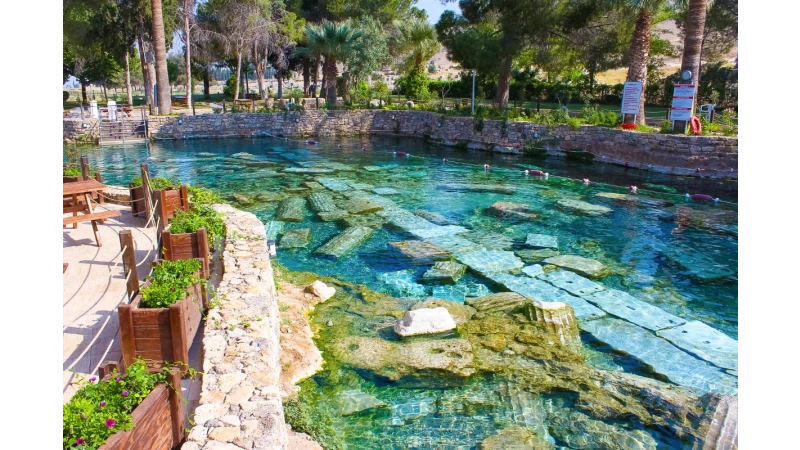Cleopatra Pool Pamukkale – Thermal Springs & Visitor Guide

Cleopatra’s Antique Pool – The Sacred Thermal Waters of Pamukkale
Introduction
At the heart of Pamukkale’s Hierapolis Ancient City lies one of Turkey’s most unique experiences: the Cleopatra Pool (Cleopatra Havuzu). This natural hot spring, filled with mineral-rich thermal waters and submerged ancient marble columns, has been attracting visitors for centuries.
According to legend, Cleopatra herself once swam here, making the pool a blend of myth, history, and wellness. Today, it is one of the highlights of any trip to Pamukkale and Hierapolis, where travelers can relax in warm waters surrounded by the ruins of a once-grand Roman spa.
📍 Related Read: Pamukkale Travertines – Cotton Castle of Turkey
History of Cleopatra’s Pool
Roman Origins
- The pool was part of the ancient spa city of Hierapolis, founded in the 2nd century BC.
- A temple dedicated to Apollo once stood nearby.
- Earthquakes caused marble columns to collapse into the pool, where they remain submerged today.
The Cleopatra Legend
- According to tradition, Egyptian Queen Cleopatra visited Pamukkale and swam in these thermal waters.
- Although the legend is debated, the name adds to the pool’s mystique and romance.
Healing Tradition
- For over 2,000 years, the waters have been considered sacred and therapeutic, used for relaxation, healing, and spiritual purification.
🔗 External Source: UNESCO – Pamukkale & Hierapolis
The Thermal Waters
- Temperature: ~36°C (96°F) year-round.
- Mineral Content: Calcium, magnesium, bicarbonate, and sulfates.
- Health Benefits: Said to help with circulation, skin conditions, rheumatism, and stress.
Visitors float among Roman column fragments, making this a truly unique spa experience unlike any modern thermal bath.
What to Expect When Visiting
- Swimming Experience
- Relax in warm turquoise waters.
- Swim among 2,000-year-old marble ruins.
- Scenery & Atmosphere
- The pool is surrounded by lush gardens, ancient ruins, and pine trees.
- Offers a surreal combination of nature and history.
- Modern Facilities
- Changing rooms, lockers, showers, and a café are available.
- The pool is divided into shallow and deeper sections.
📍 Related Read: Hierapolis Ancient City – Sacred City of Pamukkale
Practical Information
📍 Location
Inside the Hierapolis Archaeological Site, next to the Roman Baths.
🕒 Opening Hours
- Summer: 08:00 – 20:00
- Winter: 08:00 – 17:00
🎟️ Entrance Fee
- Entrance to Pamukkale + Hierapolis: 700 TL (€20).
- Cleopatra Pool requires a separate ticket (~200 TL / €6).
🔗 External Source: GoTürkiye – Cleopatra Pool
🚍 How to Get There
- By air: Denizli Çardak Airport (1 hr drive).
- By bus/train: From Istanbul, Antalya, Izmir.
- Guided tours: Often include Pamukkale Travertines + Hierapolis + Cleopatra Pool.
📍 Related Tour: 6-Day Western Turkey Tour – Istanbul, Gallipoli, Ephesus & Pamukkale
Tips for Visitors
- Bring swimwear and a towel.
- Shoes are not allowed inside the pool.
- Go early morning or late afternoon to avoid crowds.
- Stay hydrated – warm mineral waters can be tiring.
- Combine your swim with exploring Pamukkale Travertines and Hierapolis Theatre.
📍 Related Read: Kaleiçi Antalya – Old Town Visitor Guide
Why Visit Cleopatra’s Pool?
- Swim in one of the most unique thermal pools in the world.
- Experience history and wellness combined.
- Surrounded by UNESCO-listed ruins.
- Relax after exploring Pamukkale’s travertines and Hierapolis.
📍 Related Read: Olympos & Cirali – Ancient Ruins and Tranquil Beaches
SEO Optimized FAQ – Cleopatra’s Pool
1. Where is Cleopatra’s Pool located?
Inside the Hierapolis Ancient City, next to Pamukkale Travertines.
2. How warm is Cleopatra’s Pool?
Around 36°C (96°F) year-round.
3. What makes the pool unique?
Submerged marble columns from ancient earthquakes.
4. Did Cleopatra really swim here?
Legend says she did, though historically unproven.
5. Can visitors swim in Cleopatra’s Pool?
Yes, with a separate entrance ticket.
6. Is Cleopatra’s Pool healthy?
The mineral-rich waters are believed to have therapeutic benefits.
7. How much is the entrance fee?
~200 TL (€6) in addition to Pamukkale/Hierapolis ticket.
8. Is Cleopatra’s Pool family-friendly?
Yes, there are shallow areas suitable for children.
9. How long should I spend here?
1–2 hours is ideal for swimming and relaxing.
10. Is Cleopatra’s Pool part of UNESCO?
Yes, as part of the Pamukkale–Hierapolis UNESCO World Heritage Site.
Conclusion
The Cleopatra Pool in Pamukkale is one of Turkey’s most extraordinary attractions. With its thermal waters, submerged Roman columns, and legendary history, it offers a once-in-a-lifetime experience.
After exploring Pamukkale Travertines and Hierapolis, there is no better way to unwind than swimming in the same mineral waters that have attracted people for over 2,000 years.
📍 Related Experience: Pamukkale to Cappadocia Private Transfer













